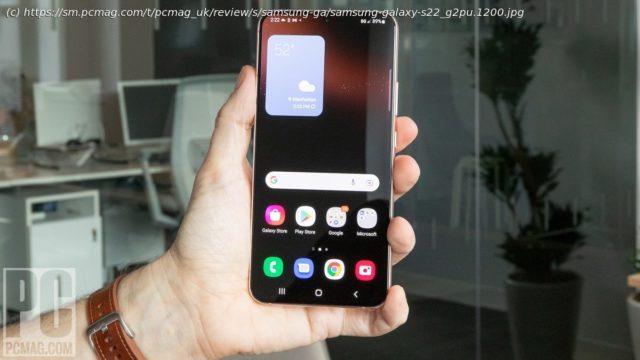The best Galaxy of the bunch
Samsung’s Galaxy S22+ ($999.99) is a crowd-pleaser. It has reliable reception, a bright screen, solid cameras, and good battery life. None of this is surprising; Samsung’s Galaxy phones are the default choices for most Android users in the US, and certainly for existing Samsung device owners who want to upgrade. The S22+ is the middle child of the S22 lineup —it doesn’t have an S Pen like the Galaxy S22 Ultra, and isn’t as compact as the S22. In other years, that could make it forgettable, but this time around the S22+ strikes the best balance between performance, value, and portability of the three. At the high end of the Android phone market in the US, the S22+ competes only with the $899 Google Pixel 6 Pro. Google’s flagship is more affordable and has better cameras, but the S22+ offers a stronger processor and cellular radio, earning it our Editors’ Choice award. A Better Body and a Delightful Display Samsung sells two versions of the S22+ in the US: each offers 8GB of RAM, but you can choose between 128GB ($999.99) or 256GB ($1,049.99) of storage. Pick carefully, because without a microSD card slot, that’s all the space you get. The design of last year’s Galaxy S21+ was disappointing for a $1,000 phone. The back material felt cheap and plasticky, especially compared with the matte-metal texture of the Galaxy S21 Ultra. That’s part of the reason why the S21 Ultra won our Editors’ Choice award instead of the S21+. The Galaxy S22+ (left) has a more durable and premium-feeling body than the Galaxy S21+ (center) or Galaxy S20+ (right) Thankfully, the Galaxy S22+ feels much more premium. The back material has a silky matte feel and seems more resistant to scratches than the even-more-matte coating on the S22 Ultra. However, the phone is very slippery. It’s on my desk right now, slowly, inexorably moving toward the edge; only the friction from the camera bump prevents it from sliding around like a hockey puck. Like all the other models in the current Galaxy lineup, the S22+ carries an IP68 rating for dust and water resistance. And like the S22, the S22+ is available in black, green, pink, or white. I tested a pink S22+ and a green S22. The pink is a delicate pastel and the green is a sober dark-forest color. At approximately 6.19 by 2.98 by 0.29 inches (HWD) and 6.91 ounces, the Galaxy S22+ is shorter and lighter than the S21+ (6.35 by 2.98 by 0.31 inches,7.13 ounces) and thus easier to handle. That said, the S22+ is still bigger and wider (albeit lighter) than the iPhone 13 Pro (5.78 by 2.82 by 0.30 inches,7.2 ounces). The Galaxy S22+ (left) seems more resistant to scratches than the S22 Ultra (right) A slight change in aspect ratio means that last year’s 6.7-inch screen is now a 6.6-inch one, but both sport the same 2,340-by-1,080-pixel resolution. I like the change; the 20:9 aspect ratio on the S21+ looked very skinny, while the 19.5:9 ratio here appears more natural to my eye. The screen on the S22+ is brighter than the one on the S21+, and just as bright as the S22 Ultra. With a peak brightness of 1,750 nits, the panel is easy to see outdoors. It refreshes dynamically between 48Hz and 120Hz, but you can lock it to 60Hz if you prefer. The S22 Ultra is the only model in the lineup with a Quad HD screen; the S22+ uses a FHD+ panel like the S22. Phones in the S22 series use the same Qualcomm ultrasonic fingerprint sensor as those in the S21 lineup, but the technology works more reliably on the newer models. Whereas my S21 Ultra has trouble with fingertip and side-of-finger touches, the S22+ registers my finger more quickly and accurately. Boosted Radio and Wi-Fi 6E Support The new Qualcomm X65 modem is absolutely a reason to upgrade to the S22+ or any of the latest Galaxy phones. This chip is the first to support AT&T’s new 3.45GHz spectrum, which is set to enhance the carrier’s performance later in 2022. Plus, it offers better reception in areas with a weak signal compared with previous models that lack the X65 modem. In testing, I found that the S22+ had a consistently stronger signal in less ideal environments compared with an S21+ that I connected to the same tower. In most cases, this advantage led to better performance. The US versions of the S22+ have a single physical SIM plus a secondary eSIM slot. Carriers may choose to disable the eSIM, however, so watch out for that complication.






